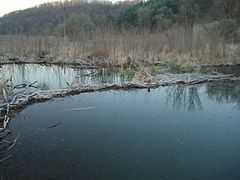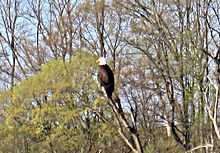Kickapoo River
| Kickapoo River | |
| stream | |
 Beaver pond on Kickapoo River watershed, 2010 | |
| Country | United States |
|---|---|
| State | Wisconsin |
| Region | Monroe County, Vernon County, Richland County, Crawford County |
| Tributaries | |
| - left | Billings Creek |
| - right | Moore Creek, Weister Creek, West Fork of the Kickapoo River, Reads Creek, Tainter Creek |
| Source | Midway between Wilton and Mill Bluff State Park |
| - location | Monroe County, Wisconsin, United States |
| - elevation | 1,200 ft (366 m) |
| - coordinates | 43°53′53″N 90°27′27″W / 43.89806°N 90.45750°W |
| Mouth | Confluence with the Wisconsin River |
| - location | Wauzeka, Wisconsin, Crawford County, Wisconsin |
| - elevation | 623 ft (190 m) |
| - coordinates | 43°04′36″N 90°52′59″W / 43.07667°N 90.88306°WCoordinates: 43°04′36″N 90°52′59″W / 43.07667°N 90.88306°W [1] |
The Kickapoo River is a 126-mile-long (203 km)[2] tributary of the Wisconsin River in the state of Wisconsin, United States. It is named for the Kickapoo[3] Indians who occupied Wisconsin before the influx of white settlers in the early 19th century.
Watershed
The river begins midway between Wilton, Wisconsin and Mill Bluff State Park and flows south through a deep valley cut into the hilly Driftless Zone of southwest Wisconsin. It empties into the Wisconsin River just south of Wauzeka, Wisconsin. Kickapoo is an Algonquian word meaning “one who goes here, then there”, a fitting name as the river is very crooked, frequently doubling back on itself as it flows through the Wisconsin landscape. Because of the extremely crooked path of the river, its source north of Wilton is just 60 miles (97 km) from its mouth at Wauzeka, although the river is nearly 130 miles (210 km) long. The Kickapoo, the longest tributary of the Wisconsin River, drains over 800 square miles (2,100 km2) of land in Monroe, Vernon, Richland, and Crawford counties. The Kickapoo River watershed encompasses 492,000 acres (1,990 km2) in southwest Wisconsin.
There are many small tributaries with the most significant being Moore Creek, Billings Creek, the West Fork of the Kickapoo, Reads Creek and Tainter Creek.[4]
Wetlands have largely been drained for pasture and comprise a tiny portion of the lands in the Kickapoo River watershed, 0.8%, whereas agriculture accounts for 50.4% of the land use followed closely by forest land at 48%.[4]
Ecology and conservation
Wildcat Mountain State Park and the Kickapoo Valley Reserve[5] form a continuous protected area. Most of the tributary streams and the Kickapoo River itself, upstream of Gays Mills, are good trout habitat due to the baseflow from coldwater springs and watershed and stream projects carried out over the recent decades.[4] The river "contains over 500 miles (800 km) of coldwater streams with populations of Brown trout (Salmo trutta) and Brook trout (Salvelinus fontinalis). Half of these streams have naturally reproducing trout populations.[6]

Recently a movement called "Save Taryn's Beaver" was launched to save a family of beavers on Weister Creek, a tributary of the Kickapoo. The beaver is a keystone species, increasing biodiversity in its territory through creation of beaver ponds and wetlands.[7] Not only are riparian habitats enlarged as the circumference of a beaver pond is much greater than the circumference of the two banks of a stream, but aquatic plants colonize newly available watery habitat. Insect, invertebrate, fish, mammal, and bird diversity are also expanded.[8] Beavers benefit bird diversity in numerous ways. Trumpeter swans (Cygnus buccinator) and Canada geese (Branta canadensis) often depend on beaver lodges as nesting sites.[8][9] As trees are drowned by rising beaver impoundments they become ideal nesting sites for obligate cavity nesters such as wood ducks (Aix sponsa), goldeneyes (Bucephala spp.), mergansers (Mergus spp.), and owls (Titonidae, Strigidae).[8] In addition, beaver ponds have been shown to increase the number of trout, their size, or both, in a study of brook trout (Salvelinus fontinalis), rainbow trout (Oncorhynchus mykiss) and brown trout (Salmo trutta).[10] These findings are consistent with a study of small streams in Sweden, that found that brown trout were larger in beaver ponds compared with those in riffle sections, and that beaver ponds provide habitat for larger trout in small streams during periods of drought.[11] The importance of winter habitat to salmonids afforded by beaver ponds may be especially important (and underappreciated) in streams without deep pools or where ice cover makes contact with the bottom of shallow streams. Cutthroat trout (Oncorhynchus clarki) and bull trout (Salvelinus confluentus) were noted to overwinter in Montana beaver ponds, brook trout congregated in winter in New Brunswick and Wyoming beaver ponds, and coho salmon in Oregon beaver ponds.[12]
In spite of the benefits of beaver to trout and bird abundance and diversity, the Wisconsin Department of Natural Resources continues to recommend removal of trees and brush from the banks of several Kickapoo river watershed streams to reduce beaver colonization.[13]
Demise of La Farge Dam

The river has a relatively low capacity for water, leading it to quickly and frequently flooding after heavy rain. In the late 1960s, the frequent floods prompted the U.S. Army Corps of Engineers to begin a dam project on the Kickapoo River near La Farge, Wisconsin. The proposed dam would have created a 1,780 acre (7.2 km²), 12-mile (19 km) long reservoir to control downstream flooding. In preparation for the construction, the government used eminent domain to buy 149 farms comprising 8,569 acres (35 km²) of land from mostly unwilling sellers. This land would have either been flooded by the dam or used as for the recreational park planned for the area around the lake.
Construction of the dam began in 1971, amid heavy opposition from Madison environmentalists and the John Muir Chapter of the Sierra Club. After many lawsuits and numerous environmental and economic studies by outside activists highlighting the negative impact of the dam, the government elected to halt construction in 1975, after spending more than $19 million and building nearly half of the dam and leaving local residents vulnerable to future flooding. The halting of the project also doomed the 1983 attempt by local residents to get government support for a smaller flood control dry dam. Lawsuits by local residents in the valley to force completion of the project was rejected.[14]
The 8,569 acres (35 km²) of land bought by the government remained in the possession of the Corps of Engineers until 1996, when it was split and parts were given to the state of Wisconsin and the Ho-Chunk Native American Tribe.[15] The Kickapoo today is a popular canoeing river.
Flooding

Because of the forced abandonment of the La Farge flood control project the Kickpoo Valley continues to suffer from catastrophic flooding. Major floods have occurred in 1978, 2007 and 2008. Soldiers Grove residents, after finally losing the battle started in 1935 to get federal flood protection resorted to moving their town in 1979 after the 1978 floods.[16] The 2007 Flooding cost well over $60 million and after the 2008 floods, communities are being forced by the Federal Emergency Management Agency (FEMA) to move from their historic locations requiring even more unwilling residents to have to relocate.
The Kickapoo River flooded over its banks in Gays Mills in 2007 and again from the June 2008 Midwest floods. The 2007 flooding cost well over $60 million and after the 2008 floods, communities are being forced by FEMA to move from their historic locations requiring even more unwilling residents to have to relocate. After several years of discussion, a planned relocation of the village began in 2010.
See also
- List of Wisconsin rivers
- Weister Creek
References
- ↑ "Kickapoo River". Geographic Names Information System. United States Geological Survey. 29 August 1980. Retrieved 2010-04-29.
- ↑ "The National Map". U.S. Geological Survey. Retrieved Feb 17, 2011.
- ↑ Gannett, Henry (1905). The Origin of Certain Place Names in the United States. Govt. Print. Off. p. 174.
- ↑ 4.0 4.1 4.2 Rapid Watershed Assessment Kickapoo River Watershed (Report). U.S. Dept. of Agriculture Natural Resources Conservation Service. July 2008. Retrieved April 29, 2010.
- ↑ "The LaFarge Dam Project". Retrieved July 22, 2007.
- ↑ Wildlife Service PDF file, Retrieved July 22, 2007
- ↑ Wright, J.P.; Jones, C.G.; Flecker, A.S. (2002). "An ecosystem engineer, the beaver, increases species richness at the landscape scale". Oecologia 132 (1): 96–101. doi:10.1007/s00442-002-0929-1.
- ↑ 8.0 8.1 8.2 Rosell F, Bozser O, Collen P, Parker H (2005). "Ecological impact of beavers Castor fiber and Castor canadensis and their ability to modify ecosystems". Mammal Review 35 (3–4): 248–276. doi:10.1111/j.1365-2907.2005.00067.x. Retrieved Mar 1, 2010.
- ↑ Brenner, F.J. (1960). "Canada geese nesting on a beaver lodge". The Auk 77 (4): 476–477. doi:10.2307/4082428.
- ↑ Gard R (1961). "Effects of beaver on trout in Sagehen Creek, California". Journal of Wildlife Management 25 (3): 221–242. doi:10.2307/3797848. JSTOR 3797848.
- ↑ Hägglund, Å. & Sjöberg, G. (1999). "Effects of beaver dams on the fish fauna of forest streams". Forest Ecology and Management 115 (2–3): 259–266. doi:10.1016/S0378-1127(98)00404-6.
- ↑ Collen P, Gibson RJ (2001). "The general ecology of beavers (Castor spp.), as related to their influence on stream ecosystems and riparian habitats, and the subsequent effects on fish – a review". Reviews in Fish Biology and Fisheries: 439–461. Retrieved Mar 2, 2010.
- ↑ Middle Kickapoo Valley Watershed (Report). Wisconsin Dept. of Natural Resources. Retrieved May 3, 2010.
- ↑ , Two Visions of the Kickapoo River: Voices For and Against the Lake LaFarge Dam Project, Cronon and Janowski 2003, Retrieved December 16, 2013
- ↑ Army Corps of Engineers, Retrieved July 22, 2007
- ↑ Soldiers Grove
External links
| Wikimedia Commons has media related to Kickapoo River. |
- Kickapoo Valley Reserve, main page, Retrieved April 29, 2010
- Wisconsin Department of Natural Resources, Retrieved July 22, 2007
- Valley Stewardship Network is a nonprofit watershed group working to preserve and protect the natural resources of the Kickapoo River area.
- KickTime is a community website that has a focus on events and news of concern to the residents of the Kickapoo Valley.
- Kickapedia is a community website that serves as a directory of local commerce and nonprofit groups in the Kickapoo Valley and wider region.
- Site for "Save Taryn's Beaver"
- "Worth a Dam" (beaver information and educational site)
- An ecological and land use history of the region, "A Thousand Pieces of Paradise" by Lynne Heasley